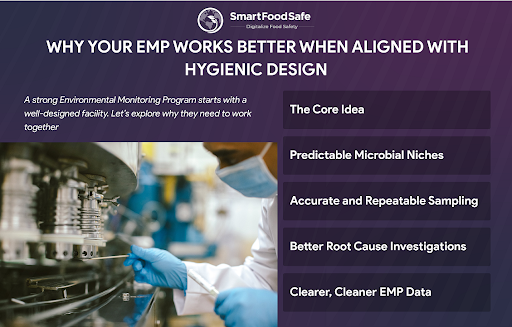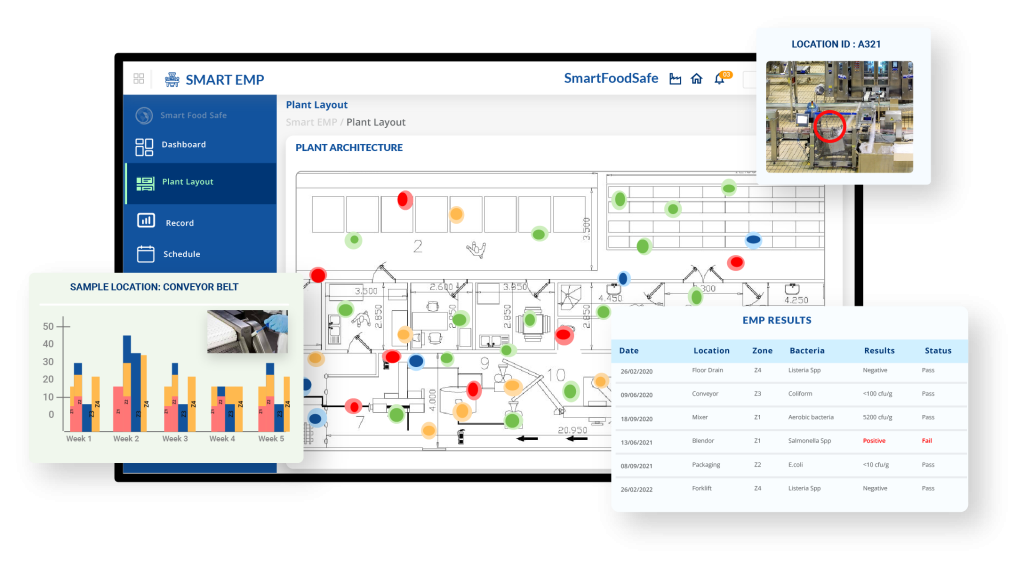
When it comes to sanitation in food facilities, the foundation lies in something simple yet powerful: if you can’t see it, then you can’t reach it, clean it or test it. This principle is at the heart of hygienic design, a critical element that ensures every corner of a food production facility can be effectively cleaned and monitored.
Consider this: a food or beverage manufacturing plant built today is expected to operate for at least 20 years. During that time, it will likely produce over a billion meals, require tens of thousands of labor hours for sanitation, and generate millions of gallons of wastewater that need treatment. The decisions made during plant construction or renovation, especially around equipment layout and cleanability can significantly influence not just cleanliness, but the plant’s operational efficiency, cost control, and competitiveness.
By aligning hygienic design principles with a smarter Environmental Monitoring Program (EMP), food manufacturers can create a powerful synergy, one that strengthens contamination prevention, simplifies verification, and supports a more purposeful approach to food safety. This article explores how pairing the two can deliver optimal results in sanitation effectiveness while future-proofing your food safety system.
What is Hygienic Design and How Does It Matter For My Food Industry?
Hygienic design refers to the way food processing equipment, facilities, and processes are designed and built to prevent contamination and make cleaning and maintenance as easy and effective as possible. The goal is to ensure that food products are safe for consumers by reducing risks from bacteria, allergens, chemicals, or foreign objects (like metal or plastic pieces). It covers everything from the materials used in equipment to the layout of your factory.
Think of it like designing a kitchen that’s easy to clean and keeps food safe: smooth surfaces, no hidden corners where dirt can hide, and equipment that’s simple to take apart and sanitize.
Maintaining an effective hygienic design for your facility assists in multiple aspects such as:
- Reduces the Risk of Contamination and Recalls
Poorly designed equipment can trap food particles, moisture, and bacteria. These hard-to-clean areas become potential contamination points, leading to cross-contact incidents, microbial growth, and even foodborne illness outbreaks. An effective hygienic design eliminates such niches, reducing the risk of product recalls, reputational damage, and regulatory penalties.
- Enables Consistent and Effective Cleaning and Sanitation
Well-designed processing equipment and facility infrastructure facilitate thorough and quick cleaning. Features such as smooth, non-porous surfaces, minimal horizontal ledges, and tool-free dismantling allow sanitation teams to remove residues efficiently. This translates into faster cleaning cycles, shorter production downtimes, and reduced chemical and water usage.
- Ensures Compliance With Global Food Safety Standards
Leading food safety regulations and certification schemes stress the importance of hygienic design as part of Hazard Analysis and Critical Control Points (HACCP) and Good Manufacturing Practices (GMP). Facilities that neglect these requirements risk receiving non-conformities during audits, facing delays in certification, or even operational shutdowns in severe cases.
- Improves Product Shelf Life, Safety, and Consistency
By preventing microbial ingress and cross-contamination, hygienic design directly contributes to higher product integrity. Clean equipment and environments help maintain optimal sensory characteristics and preserve shelf life. The result is a safer, more stable product that aligns with consumer expectations and reduces customer complaints or returns.
- Extends Equipment Lifespan and Reduces Maintenance Burdens
Using corrosion-resistant materials and eliminating unnecessary joints or fasteners not only promote hygiene but also minimize equipment wear and tear. Machinery designed for hygienic use typically withstands repeated cleaning, harsh chemicals, and thermal variations better than standard-grade equipment.
- Boosts Operational Efficiency and Plant Safety
By preventing moisture buildup, product spillage, and microbial contamination in walkways or equipment zones, it reduces slip hazards and maintains a cleaner work environment. Clearly segregated zones (e.g., raw vs. ready-to-eat areas) reduce cross-functional disruptions and streamline process flows.
Basic Principles Governing the Implementation of Hygienic Design
Here are the 10 basic rules to follow for a successful hygienic design:
1. Use Safe Materials
Use strong, food-safe materials like stainless steel or food-grade plastic. Avoid wood or coatings that can wear off or absorb moisture.
2. Make Surfaces Smooth and Easy to Clean
No rough or cracked surfaces—smooth ones are easier to clean and don’t trap bacteria.
3. Avoid Hidden or Hard-to-Reach Spots
Design equipment with rounded edges and no gaps where food or water can get stuck.
4. Ensure Proper Drainage
Surfaces and pipes should slope so that water or cleaning fluids don’t sit around and grow bacteria.
5. Allow Easy Disassembly for Cleaning
Machines should be easy to take apart without needing many tools, so cleaning can be thorough and quick.
6. Prevent Cross-Contamination
Keep raw and cooked food areas separate, and ensure allergens don’t mix with other products.
7. Use Clean Welding and Joints
All welds and joins should be smooth and sealed so that dirt and bacteria can’t collect.
8. Control Airflow and Set Up Clean Zones
Air should flow from clean areas to dirty ones, not the other way around. Use filters in critical zones.
9. Keep Non-Food Materials Out
Prevent leaks from oils, chemicals, or loose parts that could fall into the food.
10. Keep Improving
Check regularly for risks or outdated designs, and keep upgrading to stay safe and compliant.
Why Your EMP Works Better When Aligned With Your Facility’s Hygienic Design
In simple terms, an EMP is only as effective as the environment it monitors. If the facility and equipment are not designed for hygienic use, even the best EMP will struggle to detect or eliminate contamination before it becomes a problem. Here's where good design makes a difference:
⇒ Establishes Predictable Microbial Niches
Hygienically designed equipment eliminates hidden harborage points—like crevices or rough welds—that are often hard to sample and even harder to clean.
EMPs can focus on known, accessible high-risk areas (e.g., drains, air handling units, conveyor undersides), making sampling more representative and actionable. This allows EMP sampling zones to be based on scientifically valid risk assessments, rather than guesswork.
⇒ Improves Sampling Accuracy and Repeatability
Smooth surfaces, drainable slopes, and accessible structures make it easier to swab the same location consistently over time, ensuring reliable trend analysis and response. It enables meaningful comparisons across EMP data sets to detect microbial trends or deviations.
⇒ Enhances Root Cause Investigations
If contamination is found, hygienic design makes it easier to trace and isolate the source. Accessible surfaces, modular equipment, and visual cleanliness help teams act faster and more accurately during incident response. It reduces downtime and helps implement corrective actions that are targeted and effective in one go.
⇒ Reduces Background Noise in EMP Data
Poor facility design (e.g., water pooling, difficult-to-clean floors, or improperly zoned airflows) increases the presence of transient microbes and environmental contaminants, clouding EMP data.
Hygienic design minimizes such interference, giving you clearer insights. It allows more accurate evaluation of whether your sanitation procedures are working or if contamination is systemic.
Hygienic design and EMP should not operate in silos. When your environmental monitoring strategy is guided by the principles of hygienic design, it becomes more focused, more insightful, and far more powerful. Together, they form the foundational stone of a preventive, compliance-ready, and audit-friendly environmental monitoring process.
Digitally Align Your EMP With Hygienic Design Using Smart EMP
An EMP built with hygienic design in mind will work, but a comprehensive EMP solution offering digital capabilities to level up your EMP processes while integrating with hygienic design principles yield the maximum outcomes. This is what Smart EMP strives to achieve.
Here’s how Smart EMP key features enhances your facility’s hygienic foundation with digital control:
| Smart EMP's Feature | How It Aligns With Hygienic Design |
|---|---|
| Digital Plant Layout + Drag-and-Drop Tools | Visualize floor plans and pinpoint high-risk areas based on your facility's design |
| Configurable Zones & Marker Master Data | Set up sampling plans tailored to your unique design and sanitation needs |
| Heat & Harborage Mapping | Detect patterns of recurring contamination in specific design zones |
| Automated Corrective Actions + CAR Logs | Enable timely action where hygienic design makes root cause isolation easier |
| Vector Swabbing | Identify contamination vectors efficiently with accessible and cleanable design surfaces |
| Flexible Scheduling (Fixed/Random) | Match monitoring schedules to cleaning cycles and known design-based risk timelines |
Smart EMP brings structure, digital intelligence, and operational consistency to your environmental monitoring activities. It enables you to adapt your EMP dynamically as your facility evolves, ensuring you are always aligned with industry best practices and regulatory expectations.



